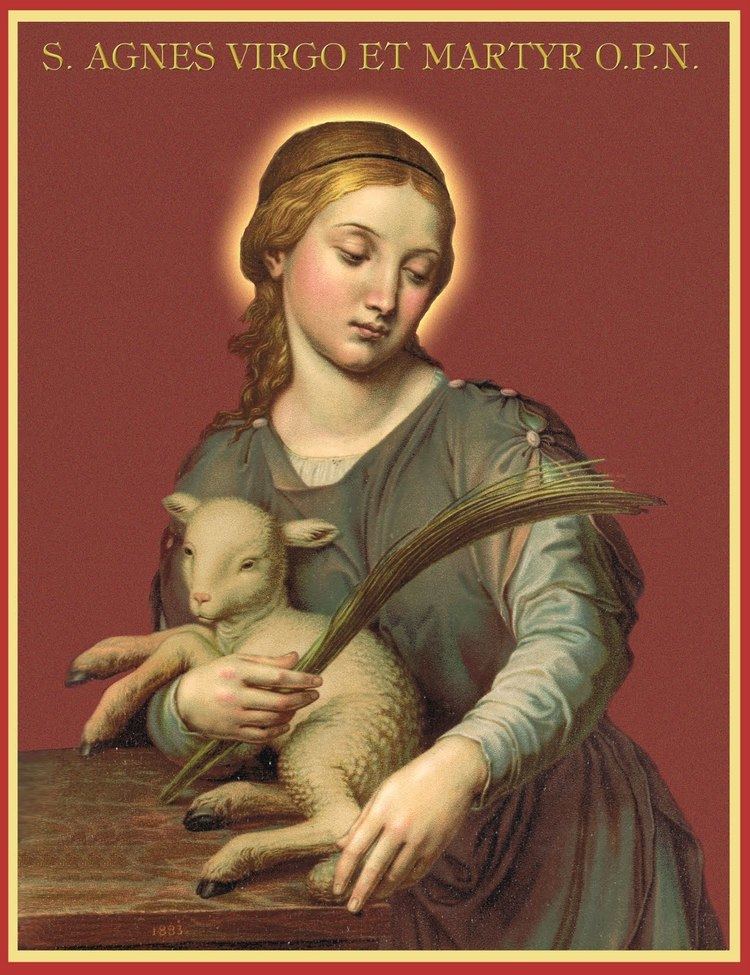Canonized Pre-congregation Role Martyr | Name Agnes Rome Attributes a lamb, martyr's palm Patronage Gardening, New York | |
 | ||
Venerated in Roman Catholic Church, Eastern Catholic Churches, Eastern Orthodox Churches, Oriental Orthodox Churches, Anglican Communion, Lutheranism Major shrine Church of Sant'Agnese fuori le mura and the Church of Sant'Agnese in Agone, both in Rome Feast 21 January; before Pope John XXIII revised the calendar, there was a second feast on January 28 Similar People John the Baptist, John the Evangelist, Mary Magdalene, Emerentiana, Helena | ||
St agnes of rome 035 avi
Agnes of Rome (c. 291 – c. 304) is a virgin–martyr, venerated as a saint in the Roman Catholic Church, Eastern Orthodox Church, the Anglican Communion, and Lutheranism. She is one of seven women, who along with the Blessed Virgin, are commemorated by name in the Canon of the Mass. She is the patron saint of chastity, gardeners, girls, engaged couples, rape survivors, virgins, and the Children of Mary.
Contents
- St agnes of rome 035 avi
- St agnes hd
- Biography
- Veneration
- Patronage
- Churches
- Schools
- Legacy
- Iconography
- In popular culture
- References

Agnes is depicted in art with a lamb, as the Latin word for "lamb", agnus, sounds like her name. The name "Agnes" is actually derived from the feminine Greek adjective hagnē (ἁγνή) meaning "chaste, pure, sacred".

Agnes' feast day is 21 January. In pre-1970 versions of the General Roman Calendar an additional feast of the same saint is given one week later, on 28 January (see Tridentine Calendar). The 1969 revision removed this as a duplication of the 21 January feast.

St agnes hd
Biography
According to tradition, Saint Agnes of Rome was a member of the Roman nobility born in AD 291 and raised in an Early Catholic family. She suffered martyrdom at the age of twelve or thirteen during the reign of the Roman Emperor Diocletian, on 21 January 304.
Agnes was a beautiful young girl of wealthy family and therefore had many suitors of high rank. Details of her story are unreliable, but legend holds that the young men, slighted by her resolute devotion to religious purity, submitted her name to the authorities as a follower of Christianity.
The Prefect Sempronius condemned Agnes to be dragged naked through the streets to a brothel. Various versions of the legend give different methods of escape from this predicament. In one, as she prayed, her hair grew and covered her body. It was also said that all of the men that attempted to rape her were immediately struck blind. In another the son of the prefect is struck dead, but revived after she prayed for him, causing her release. There is then a trial from which Sempronius excuses himself, and another figure presides, sentencing her to death. She was led out and bound to a stake, but the bundle of wood would not burn, or the flames parted away from her, whereupon the officer in charge of the troops drew his sword and beheaded her, or, in some other texts, stabbed her in the throat. It is also said that her blood poured to the stadium floor where other Christians soaked it up with cloths.
Agnes was buried beside the Via Nomentana in Rome. A few days after her death, her foster-sister, Saint Emerentiana, was found praying by her tomb; she claimed to be the daughter of Agnes' wet nurse, and was stoned to death after refusing to leave the place and reprimanding the pagans for killing her foster sister. Emerentiana was also later canonized. The daughter of Constantine I, Saint Constance, was also said to have been cured of leprosy after praying at Agnes' tomb. She and Emerentiana appear in the scenes from the life of Agnes on the 14th-century Royal Gold Cup in the British Museum.
An early account of Agnes' death, stressing her young age, steadfastness and virginity, but not the legendary features of the tradition, is given by Saint Ambrose.
Veneration
Agnes was venerated as a saint at least as early as the time of St. Ambrose, based on an existing homily.
Agnes's bones are conserved beneath the high altar in the church of Sant'Agnese fuori le mura in Rome, built over the catacomb that housed her tomb. Her skull is preserved in a separate chapel in the church of Sant'Agnese in Agone in Rome's Piazza Navona.
Patronage
Agnes is the patron saint of young girls. Folk custom called for them to practise rituals on Saint Agnes' Eve (20–21 January) with a view to discovering their future husbands. This superstition has been immortalised in John Keats's poem, The Eve of Saint Agnes.
Churches
Schools
Legacy
The Congregation of Sisters of St. Agnes is a Roman Catholic religious community for women based in Fond du Lac, Wisconsin. It was founded in 1858, by Father Caspar Rehrl, an Austrian missionary, who established the sisterhood of pioneer women under the patronage of Agnes, to whom he had a particular devotion.
It is customary on her feast day for two lambs to be brought from the Trappist abbey of Tre Fontane in Rome to be blessed by the Pope. On Holy Thursday they are shorn, and from the wool is woven the pallium which the pope gives to a newly consecrated metropolitan archbishop as a sign of his jurisdiction and his union with the pope.
Iconography
Since the Middle Ages, Agnes has traditionally been depicted as a young girl in robes, with a lamb, the symbol of her virginal innocence, and often, like many other martyrs, with a palm branch.
In popular culture
Hrotsvitha, the tenth-century nun and poet, wrote a play about Agnes. Grace Andreacchi wrote a play based on the legends surrounding Agnes's martyrdom.
In the historical novel Fabiola or, the Church of the Catacombs, written by Cardinal Nicholas Wiseman in 1854, Agnes is the soft-spoken teenage cousin and confidant of the protagonist, the beautiful noblewoman Fabiola.
